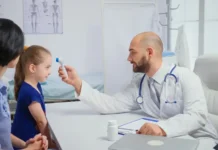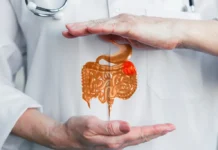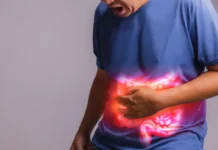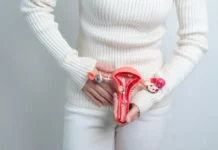Hidradenitis suppurativa, also referred to as acne inversa, is a medical condition characterized by the formation of painful, small lumps beneath the skin’s surface. These lumps typically emerge in areas where skin friction occurs, such as the armpits, groin, buttocks, and breasts. Regrettably, these lumps have a slow healing process, often reappear, and can give rise to subcutaneous tunnels and scarring.
The onset of hidradenitis suppurativa generally commences after puberty, commonly before the age of 40. This condition can endure for numerous years and escalate progressively. Its impact can extend to both daily life and emotional equilibrium. Employing a combination of medical and surgical approaches can effectively manage the condition and stave off potential complications.
Statistics reveal that women are three times as likely to develop hidradenitis suppurativa as men, although this proportion may fluctuate based on geographical location. Moreover, individuals of black ethnicity are more predisposed to this ailment compared to those from other racial backgrounds. Genetic factors are presumed to contribute to these disparities.
Symptoms of Hidradenitis Suppurativa
Hidradenitis suppurativa can manifest in singular or multiple areas of the body, presenting with the following signs and symptoms:
Comedones (blackheads): In the later stages of the condition, small black bumps might emerge on the skin. These are referred to as double-headed blackheads due to their tendency to appear in pairs. These appear within small, pitted regions of the skin, often appearing in pairs.
Painful Pea-sized Nodules: The initial manifestation of hidradenitis suppurativa typically involves a painful nodule beneath the skin’s surface, commonly appearing in areas prone to friction such as the armpits or groin. These nodules can persist for weeks or months before rupturing into an abscess and releasing pus. Following this, another nodule may develop either in the same location or nearby.
Typically, the condition initiates with a solitary, painful nodule beneath the skin’s surface, persisting for weeks or months. Subsequently, additional bumps may emerge, primarily in areas abundant in sweat and oil glands or where skin friction occurs, such as the armpits, groin, buttocks, and breasts.
Draining Bumps or Ulcers: Some nodules or ulcers enlarge, rupture, and expel pus with an associated odour.
Tunnel Formation: As time progresses, tunnels might develop beneath the skin, connecting these nodules. These passageways exhibit slow or incomplete healing and may discharge blood and pus.
The course of the disease exhibits considerable variability, with certain individuals experiencing only mild symptoms. While excess weight and smoking are correlated with more severe symptoms, it’s important to note that even individuals who are slender and non-smokers can experience severe forms of the disease.
When Should You Consult a Doctor for Hidradenitis Suppurativa?
Early diagnosis of hidradenitis suppurativa is imperative for effective management. It is advisable to consult a dermatologist if:
- The condition is causing pain.
- Movement becomes restricted due to the condition.
- Improvement isn’t observed within a few weeks.
- Recurrence occurs shortly after treatment.
- The condition emerges in multiple locations or frequently flares up.
- Dermatologists can formulate a tailored treatment strategy for each individual.
Hidradenitis suppurativa transcends the characteristics of a mere boil. Many individuals with this condition also present with associated conditions. A comprehensive healthcare team, with medical and surgical dermatologists at its core, is beneficial for managing hidradenitis suppurativa. Additional specialists are engaged as deemed necessary.
What Are the Indications and Symptoms of Hidradenitis Suppurativa?
If you develop hidradenitis suppurativa, you are likely to encounter the following symptoms, often occurring sequentially:
Nodules and Lesions: The initial manifestation of hidradenitis suppurativa typically involves a painful nodule beneath the skin’s surface, commonly appearing in areas prone to friction such as the armpits or groin. These nodules can persist for weeks to months before rupturing into an abscess and releasing pus. Following this, another nodule may develop either in the same location or nearby.
Formation of Tunnels: Over time, if you have had hidradenitis suppurativa for an extended duration, multiple deeply situated nodules are likely to be present. These nodules can give rise to tunnels or pathways connecting them beneath the skin. These tunnels might sporadically release pus.
Development of Blackheads: In the later stages of the condition, small black bumps might emerge on the skin. These are referred to as double-headed blackheads due to their tendency to appear in pairs.
Scarring: Following the regression and healing of a nodule or lesion, thick, ribbon-like scars may develop on the skin. Additionally, “ice pick (pitted) scars” similar to those associated with severe or cystic acne might also become apparent.
Hidradenitis suppurativa is a persistent condition. It’s feasible that symptoms could be intermittently alleviated for periods of time, only to resurface over the course of decades.
Is hidradenitis suppurativa contagious?
Hidradenitis suppurativa (HS) is not contagious, as it’s not linked to infection. It’s an autoinflammatory ailment affecting hair follicles, leading to painful boils and abscesses. This skin disease, more common in women with a family history, can result in scarring. Diagnosis involves a physical exam, and treatment encompasses medication like antibiotics and surgical options. Coping with feelings of isolation and depression is typical; seeking counselling is beneficial. Lowering flare-up risks can be achieved by avoiding smoking and managing weight, if necessary.
Is hidradenitis suppurativa due to an STD?
Absolutely not, HS is not transmitted through sexual contact—it’s not an STD. Even though it might appear in the genital or groin areas, it remains non-contagious. While grappling with HS, learning that it has no cure is tough. My experience began at 13, but it wasn’t until 23 that I got a diagnosis after various doctors, failed treatments, and surgeries. Despite increasing research and treatments, HS persists as a lifelong condition. Early detection aids symptom management and can prevent irreversible skin damage down the line.
Is hidradenitis suppurativa the same as acne conglobata?
Certain individuals with HS might develop a severe acne type called acne conglobata. Acne Vulgaris and Acne Conglobata
Both acne vulgaris and HS involve chronic inflammation of the pilosebaceous unit. Acne conglobata is an intense inflammatory variant leading to tender nodules, double comedones, and sinus tract formation—also seen in HS, often termed acne inversa. Acne vulgaris/conglobata prevalence in HS patients ranges from 4.5% to 15.2%, significantly higher than non-HS patients (0.9% to 6.2%). The odds of HS patients developing acne vulgaris/conglobata are up to 5 times higher. While isotretinoin treats acne, its monotherapy benefit in HS is limited. A modified approach is needed for both conditions.
Hidradenitis suppurativa (HS) links integumentary and systemic disease due to its chronic inflammation. Various observations tie HS to multiple organ systems’ comorbidities. The global burden of HS’s comorbidities rivals psoriasis and systemic diseases like lupus, dermatomyositis, and ankylosing spondylitis. Comorbidities worsen health, quality of life, and mortality rates. Addressing these alongside HS can enhance health advocacy and comprehensive patient care.
Does poor hygiene cause hidradenitis suppurativa?
No, Hidradenitis Suppurativa (HS) isn’t linked to poor hygiene. HS is an autoinflammatory condition affecting hair follicles, leading to painful recurrent abscesses in sweaty body areas. Although there’s no cure, treatment can alleviate symptoms.
This skin ailment causes pimple-like bumps or boils on and under the skin, being chronic and often painful. HS is not contagious.
The condition originates in hair follicles, usually in skin areas prone to friction. Contrary to misconceptions, inadequate hygiene practices like infrequent bathing or hair washing do not trigger HS. In the majority of cases, the exact cause remains unknown.
What causes hidradenitis suppurativa?
HS is a hair follicle-centered autoinflammatory ailment. The body’s attack on follicles leads to abscesses, chronic inflammation, and scarring.
The precise cause of hidradenitis suppurativa remains uncertain as researchers investigate genetic alterations, hormones, and environmental factors as potential triggers.
Importantly, HS doesn’t transmit person-to-person, and misconceptions about hygiene’s role are dispelled. Poor personal habits, like infrequent bathing, don’t cause the disease.
Despite its name, HS is an autoinflammatory syndrome rather than a sweat gland disorder. Its pathogenesis, involving factors like follicular occlusion, disrupted microbiome, and inflammatory responses, still requires full understanding.
Blocked hair follicles contribute to the formation of HS lumps. Smoking and obesity worsen symptoms, with a strong association.
Onset often aligns with puberty, hinting at hormonal involvement. Many with HS also experience acne and excess hair growth.
In certain cases, HS might correlate with Crohn’s disease, particularly in the groin and anal areas. Crohn’s disease inflames the digestive tract lining. About 1 in 3 cases of HS have a familial link. Not infectious, HS is unrelated to poor hygiene.
What types of skin growth does HS cause?
Hidradenitis suppurativa manifests as a blend of boil-like lumps, blackheads, cysts, scarring, and skin channels that discharge pus. It prompts the growth of fleshy lumps on the skin’s surface, accompanied by the formation of narrow sinus tracts beneath, leading to pus leakage.
The condition typically begins with blackheads, pus-filled spots, and firm pea-sized lumps at a specific location. These lumps either vanish or burst, releasing pus within hours or days. This can then lead to the emergence of fresh lumps nearby. Without effective medical intervention, these can enlarge and spread. Sinus tracts, narrow passages under the skin, also develop, eventually breaking out on the skin’s surface and releasing pus.
Hidradenitis suppurativa brings substantial pain. The lumps arise in various areas:
- Around the groin and genital region
- In the armpits
- Around the anal area and buttocks
- Below the breasts
These lumps might also emerge on the neck’s base, waistband, and inner thighs. Some lumps might become infected by bacteria, leading to secondary infections necessitating antibiotic treatment.
Many individuals with hidradenitis suppurativa also develop pilonidal sinuses, small tunnels in the skin’s upper buttock area where the buttocks meet.
Who is more likely to experience hidradenitis suppurativa?
Hidradenitis suppurativa (HS) is more likely to affect individuals who are women or assigned females at birth (AFAB) compared to men or assigned males at birth (AMAB).
Additional risk factors comprise:
- Excessive hair growth (hirsutism).
- A family history of HS.
- Hormonal fluctuations (estrogens and androgens) are common after puberty and before menopause.
- Smoking.
- Obesity.
Females have a higher susceptibility to HS than males, and it’s more prevalent among African Americans than Caucasians. HS typically emerges during puberty.
Certain factors can heighten the likelihood of developing HS:
- Having a family member with the disease.
- Being overweight or obese.
- Smoking.
Certain individuals possess an elevated risk of HS development. Researchers have identified several risk factors:
- Family history: HS can run in families; many with HS have affected relatives.
- Triggers: HS often needs a triggering factor. Cigarette smoking is believed to be a common trigger, affecting 70% to 90% of HS cases.
- Obesity is also linked to HS; higher weight correlates with increased risk and severity.
- Gender: Females are more prone than males, possibly linked to hormonal influences, as HS can flare before menstruation and ease during pregnancy and menopause.
- Age: HS typically arises between puberty and around 40 years of age, rarely before puberty.
- Race: In the US, African Americans, Hispanics, and biracial individuals experience higher HS rates than whites, with more severe cases in African Americans.
- Psoriasis: Individuals with psoriasis have a heightened HS risk.
While HS’s exact cause remains unclear, these insights enhance our understanding and treatment approaches. Treatment often involves a combination of medication, skin care, and self-care.
What are common complications of HS?
Hidradenitis suppurativa (HS), a chronic inflammatory skin disorder, features recurring painful nodules and abscesses in skin folds. Prolonged episodes of intense inflammation in HS can give rise to various complications, greatly impacting quality of life.
These complications may manifest solely on the skin’s surface or have wider systemic effects. Cutaneous complications include sinus tracts, fistulas, scarring, contractures, squamous cell carcinoma, and lymphedema. Systemic complications encompass chronic pain, potential systemic amyloidosis, and anaemia. Effective HS management includes curbing disease complications. Clinicians should swiftly identify these issues for timely intervention and reduce negative consequences.
Untreated HS over time elevates the risk of:
- Anemia
- Cellulitis
- Lymphatic system impairment
- Fistulas, abnormal connections between skin and bowel/bladder
- Scarring
- Sepsis
- Rare instances of skin cancer
HS complications encompass:
- Secondary infections
- Psychological distress and diminished quality of life
- Pyogenic granuloma
- Lymphedema in female genital regions
- Squamous cell carcinoma in male anogenital areas
- Anaemia associated with chronic disease
How is Hidradenitis Suppurativa severity evaluated?
Disease severity and extent are gauged through clinical and ultrasound assessments at diagnosis and during treatment monitoring. Several severity scales, like the Hurley system, are employed for HS assessment. The Hurley system categorizes HS into three clinical stages:
- Stage I: Isolated abscess formation without sinus tracts or scarring
- Stage II: Recurrent abscesses with sinus tract formation
- Stage III: Extensive involvement with interconnected sinus tracts and abscesses
Diagnosing Hidradenitis Suppurativa
Timely diagnosis and treatment of hidradenitis suppurativa are vital for symptom management and prevention of new lesions. Physicians often identify the condition by examining the skin for characteristic boils in specific areas. In some cases, fluid from the lumps and blood tests might be conducted to rule out other potential diagnoses.
Hidradenitis suppurativa can be misidentified as pimples or acne, leading to years of incorrect diagnosis for many individuals.
Diagnosis relies on your signs, symptoms, skin appearance, and medical history. Referral to a dermatologist, who specializes in skin conditions, might be necessary. Due to its complexity, hidradenitis suppurativa demands specialized care and often defies a simple diagnosis.
While no specific laboratory test exists, if pus or drainage is present, samples might be taken for testing. Dermatologists, often the primary diagnosticians, can prevent HS progression through accurate diagnosis and tailored treatment plans.
How Do Dermatologists Diagnose Hidradenitis Suppurativa?
Hidradenitis suppurativa (HS) can resemble other skin issues such as worsening acne, boils, or herpes. Dermatologists possess the expertise to differentiate HS from these conditions, enabling swift diagnosis.
In the event of suspected HS, dermatologists typically:
- Inquire about the locations of lumps, drainage, and other HS signs, as they tend to manifest in specific areas.
- Examine the bumps and sores, noting distinctive features that distinguish HS from acne, boils, and others.
- Discuss their observations with you, inquiring about symptoms and specific timing to ensure an accurate diagnosis.
- If fluid leakage is present, a swab sample might be taken for testing, aiding in infection assessment.
Typically, this process is sufficient for HS diagnosis. Should HS be confirmed, a personalized treatment plan is crafted by the dermatologist to address your unique needs.
Treating Hidradenitis Suppurativa: Options and Approaches
The treatment of hidradenitis suppurativa (HS) is tailored to the severity of symptoms. In the early stages, your care plan may encompass:
Skin Care Strategy
Dermatologists may recommend specific products to support your skin:
- Gentle antiperspirants for delicate skin.
- Daily antiseptic wash to cleanse affected areas.
- Inflammation-reducing retinoids containing vitamin A.
- Specific types of body wash.
Pain Management
Managing HS pain involves various therapies:
- Complementary methods like dietary techniques and acupuncture.
- Application of ice packs or warm compresses.
- Use of lidocaine skin cream or ointment.
- Over-the-counter or prescribed pain medications.
- Referral to a pain management specialist.
Advanced Medical Therapies
Additional medications targeting HS symptoms include:
- Adalimumab is a biological therapy to dampen the immune system’s response, easing inflammation.
- Antibiotics, not for infection treatment, but to address inflammation driving HS. Low-dose antibiotics might be prescribed for ongoing inflammation over three months.
- Metformin is a diabetes medication that may normalize hormone levels and reduce insulin resistance.
- Birth control pills to regulate hormones and mitigate premenstrual flares.
Advanced HS Therapies
For severe symptoms or unresponsive growths, procedures might be necessary. Options include:
- Botox® injections to manage excessive sweating.
- Deroofing surgery to remove sinus tract coverings.
- Incision and drainage for abscess treatment.
- Laser hair removal.
- Laser surgery to eliminate HS boils.
- Steroid injections for inflammation reduction.
For an in-depth, evidence-based review of HS treatment, refer to the “Management of Hidradenitis Suppurativa: An Australasian Consensus Statement.” The following outlines key measures and medical interventions.
General Approaches
General strategies for treating HS involve:
- Weight loss
- Smoking cessation
- Wearing loose-fitting clothing
- Using absorbent dressings
- Analgesics
- Addressing anxiety and depression, reinforcing that HS isn’t infectious or due to poor hygiene.
Specific Medical Interventions
Specific medical tactics for HS include:
Topical treatments
- Triclosan/benzoyl peroxide wash
- Topical clindamycin phosphate 1% with benzoyl peroxide
- Topical antibiotics: fusidic acid, dapsone, metronidazole.
Systemic treatments
- Antibiotics for bacterial infections
- Short oral course for acute staphylococcal abscess
- Prolonged combination antibiotics
- Intravenous ertapenem.
Other oral treatments
- Hormonal therapies
- Immunomodulatory treatments
- Biologics (e.g., adalimumab)
- Other systemic medical treatments (e.g., metformin, acitretin).
Surgical and Procedural Measures
For certain cases, surgical and procedural options are considered:
- Incision and drainage of abscesses
- Local excision of persistent nodules, abscesses, and sinuses
- Deroofing and curettage of persistent abscesses and sinuses
- Radical excisional surgery
- Laser ablation (CO2) for nodules, abscesses, and sinuses
- Laser/light hair removal.
Consult your healthcare provider to determine the most suitable treatment path for your HS condition.
Preventing Hidradenitis Suppurativa: Practical Advice
Although some risk factors are beyond your control, you can take proactive measures to minimize HS flare-ups and complications:
- Stay indoors during hot weather to limit sweating.
- Address obesity through weight loss.
- Avoid scented skin products and deodorants.
- Quit smoking if you use tobacco.
- Opt for loose-fitting clothing.
Dermatologists’ Guiding Advice
Patients often inquire whether squeezing HS lesions is advisable, but it’s discouraged. Squeezing or popping nodules, cysts, and sores can harm and inflame the skin, exacerbating HS.
To enhance the results of HS treatment at home, dermatologists recommend the following steps:
- Cleanse skin with an antimicrobial wash to reduce bacteria.
- Consider acne wash with benzoyl peroxide or zinc pyrithione to diminish bacterial presence.
- Avoid harsh scrubbing as it causes inflammation, worsening HS.
- Be cautious while shaving or waxing areas affected by HS.
- For shaving, use antibacterial soap before applying gel-to-foam shaving gel, then shave carefully.
- Laser hair removal can help by reducing follicles, bacteria, and sebaceous gland activity.
- Heat application on painful lumps can alleviate discomfort through methods like black tea compress or warm water compress.
- While heat can provide relief, sweating and overheating should be avoided, as they worsen HS.
- Choose mild, skin-friendly antiperspirants or deodorants without irritating ingredients.
- Follow wound-care treatment plans to heal and prevent infection in case of HS-related wounds.
- Opt for looser clothing to minimize friction-induced irritation during HS flare-ups.
- Joint pain should be communicated to dermatologists due to HS-related joint disease risks.
Lifestyle Changes for Long-Term Benefits
Quitting smoking and weight loss can lead to fewer HS flare-ups and improvement in the condition:
- Weight loss can reduce flare-ups and, in some cases, eliminate HS.
- Smoking cessation not only promotes overall health but also lessens HS flare-ups.
Although challenging, quitting smoking is supported by programs such as the American Lung Association’s Freedom from Smoking, recognized for its effectiveness.
Your dermatologist can offer personalized advice tailored to your HS condition, optimizing your self-care approach.
Living with Hidradenitis Suppurativa: Navigating Challenges and Coping
Living with Hidradenitis Suppurativa (HS) goes beyond the skin, affecting physical, mental, and emotional well-being. As there’s no cure, adapting to daily life while managing HS can be a significant adjustment.
Impact on Daily Life
HS initiates with blocked hair follicles leading to bumps, progressing to abscesses, inflammation, and scarring. Although HS’s overall psychological and daily-life impact is not extensively studied due to its rare nature, research reveals its profound mental and emotional effects.
Challenges of Living with HS
The HS journey varies for each individual. Symptoms may range from mild to severe, causing hidden discomfort or pain. Even if the skin symptoms are mild, the unseen pain can be challenging for others to grasp. The visible signs, including large, painful, malodorous lesions, can trigger emotional distress, pain, and worry.
Anger, irritability, depression, and anxiety are common due to HS symptoms. Social withdrawal may occur, intensifying depressive or anxious feelings. Consulting a doctor is crucial if experiencing these emotions, as support is available.
Impact on Relationships
Explaining HS to others can be tough. Those close to you will want to understand. Open communication is key, whether with partners or healthcare providers. Discussing flare-ups with your partner is important, and mutual adjustments can be made.
Maintaining a strong doctor-patient relationship is vital. Prepare questions before appointments, as mental and emotional health are as essential as physical health.
Coping Strategies
Self-awareness of thoughts, feelings, and reactions to HS is the initial step to coping. Once understood, communicate with loved ones. Mental and emotional health matter, and talking to a doctor about these aspects is essential.
Online communities can offer valuable support. Surrounding yourself with understanding and supportive individuals contributes to a fulfilling quality of life while managing HS.
Personal Experience
Initially, symptoms resembling ingrown hairs troubled a woman in her groin area. Though the bumps disappeared, they later appeared under her underarms, larger and more persistent. A painful experience at urgent care led to diagnosis with HS, a chronic condition causing painful lumps in sweat glands. After years, she finally had a name for her struggle, emphasizing the importance of support.
Diagnosis Challenges
Hidradenitis Suppurativa affects 1-4% of the global population. Despite its debilitating effects, diagnosis often takes years. A seven-year delay is common due to a series of visits to general practitioners rather than dermatologists who specialize in HS. Even dermatologists might lack familiarity due to its rarity.
Living with HS is a multi-faceted journey that affects various aspects of life. From understanding the condition to seeking proper treatment and support, individuals can navigate the challenges and find ways to improve their overall well-being.














